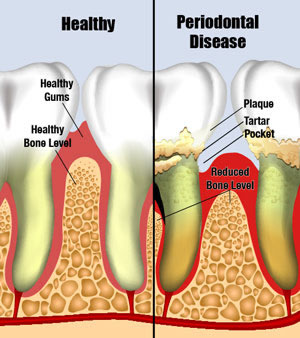Gum Disease: You Probably Have It And Don’t Know It
 Every day, 24-hours a day, over 500 unique types of wiggling germs are living in your mouth. And that’s just KINDS of bacteria. Given that each kind can consist of well over 100,000 bacteria, it becomes clear why dentists say that your mouth has more bacterial residents than there are people in New York city. And, just like New York city, they NEVER sleep. They only do two things: chow down on food left in your teeth and make more bacteria.
Every day, 24-hours a day, over 500 unique types of wiggling germs are living in your mouth. And that’s just KINDS of bacteria. Given that each kind can consist of well over 100,000 bacteria, it becomes clear why dentists say that your mouth has more bacterial residents than there are people in New York city. And, just like New York city, they NEVER sleep. They only do two things: chow down on food left in your teeth and make more bacteria.
Well, actually, there is one more thing the bacteria do and that’s what causes all the problems. They excrete waste product. That bacteria poop is toxic to your teeth and gums.
Gum disease is caused by plaque, the ugly coating of bacteria poop that constantly builds up on your teeth. The bacteria’s poop (plaque) contains chemicals that can damage the teeth and gums.
Common symptoms of gum disease are:
• bleeding gums after brushing
• cherry red color to gums
• sores on the gums
• red, puffy gums
• bad breath
With regular professional cleanings and a quality at-home oral hygiene routine, the plaque can be kept to a minimum and gum disease can be averted. Even the damaging effects of gum disease are also amazingly easy to heal if treated early by Dr. Cameron.
Our hygienists provide gentle, thorough cleanings that remove the plaque coating that normal brushing doesn’t reach. They also offer education and instruction on how to get rid of the most plaque possible at home.
Gum disease is deceptively painless early on, so you may not know you have it. Couple that with the fact that gum disease is nearly impossible for the patient to self-diagnose and it becomes obvious why you need to see us regularly. At each checkup, Dr. Cameron and a Romie Lane Dental Group hygienist will take depth readings of the shallow, v-shaped crevice (called a sulcus) between your teeth and gums to determine if you have gum disease.
Gum disease attacks just below the gum line in the sulcus, where it damages the supporting and connective tissues. As the tissues are damaged, the sulcus develops into a pocket; generally, the more severe the disease, the greater the depth of the pocket. In fact, the pocket can get so deep that your tooth is no longer attached to your gums or jawbone. And, that’s when they fall out.
Contact Us
- Romie Lane Dental Group
- Soraya Cameron, DDS
- 770 E. Romie Lane
- Salinas, CA 93901
- (831) 424-3035

